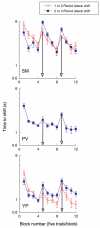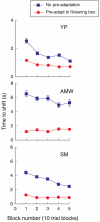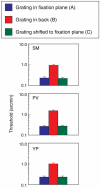The wallpaper illusion explained
- PMID: 18217805
- PMCID: PMC2365498
- DOI: 10.1167/7.14.10
The wallpaper illusion explained
Abstract
In the wallpaper illusion, a repetitive pattern appears to shift from one depth plane to the plane nearest fixation. We measured the timing of this shift for a 6 degrees wide, 3-cpd sinusoidal grating presented in a rectangular envelope; the edges (envelope) of the grating were presented at 20 arcmin of disparity (one period) behind the fixation plane. We asked observers to signal when the segment appeared to move from the edge plane forward to the fixation plane. Initially, the shift from the edge plane took 4-6 s, but after many trials, the shift became faster. Additional experiments demonstrated that the envelope was adapting, thereby permitting the alternative match. Our measurements for a range of spatial frequencies and disparities showed that these shifts to the fixation plane occurred only if the envelope disparity was more than one-half period of the carrier; that is, phase disparity >180 degrees. We also found that stereoacuity for the initial envelope-based match was poor, as might be expected for a target presented far off the fixation plane. However, once the perceived shift in depth occurred, stereoacuity improved fivefold without any change in the physical stimulus. We speculate that access to the most sensitive V1 neurons depends on the extrastriate processes that determine perceived depth--in this case, second-order envelope mechanisms.
Figures









Similar articles
-
Motion-induced position shift in stereoscopic and dichoptic viewing.J Vis. 2016 Oct 1;16(13):3. doi: 10.1167/16.13.3. J Vis. 2016. PMID: 27776360
-
Stereo sensitivity depends on stereo matching.J Vis. 2005 Nov 23;5(10):783-92. doi: 10.1167/5.10.3. J Vis. 2005. PMID: 16441185 Free PMC article.
-
What is the depth of a sinusoidal grating?J Vis. 2004 Jun 29;4(7):524-38. doi: 10.1167/4.7.1. J Vis. 2004. PMID: 15330699
-
The role of the cyclopean eye in vision: sometimes inappropriate, always irrelevant.Vision Res. 2002 Apr;42(9):1157-63. doi: 10.1016/s0042-6989(01)00280-2. Vision Res. 2002. PMID: 11997054 Review.
-
3-D vision and figure-ground separation by visual cortex.Percept Psychophys. 1994 Jan;55(1):48-121. doi: 10.3758/bf03206880. Percept Psychophys. 1994. PMID: 8036093 Review.
Cited by
-
"What Not" Detectors Help the Brain See in Depth.Curr Biol. 2017 May 22;27(10):1403-1412.e8. doi: 10.1016/j.cub.2017.03.074. Epub 2017 May 11. Curr Biol. 2017. PMID: 28502662 Free PMC article.
-
The venetian-blind effect: a preference for zero disparity or zero slant?Front Psychol. 2013 Nov 11;4:836. doi: 10.3389/fpsyg.2013.00836. eCollection 2013. Front Psychol. 2013. PMID: 24273523 Free PMC article.
-
Absolute Depth Sensitivity in Cat Primary Visual Cortex under Natural Viewing Conditions.Front Syst Neurosci. 2016 Aug 5;10:66. doi: 10.3389/fnsys.2016.00066. eCollection 2016. Front Syst Neurosci. 2016. PMID: 27547179 Free PMC article.
-
Contextual effects on binocular matching are evident in primary visual cortex.Vision Res. 2019 Jun;159:76-85. doi: 10.1016/j.visres.2019.04.001. Epub 2019 Apr 16. Vision Res. 2019. PMID: 30980834 Free PMC article.
-
Stereopsis is adaptive for the natural environment.Sci Adv. 2015 May;1(4):e1400254. doi: 10.1126/sciadv.1400254. Sci Adv. 2015. PMID: 26207262 Free PMC article.
References
-
- Arditi A, Kaufman L, Movshon JA. A simple explanation of the induced size effect. Vision Research. 1981;21:755–764. - PubMed
-
- Brewster D. On the knowledge of distance given by binocular vision. Transactions of the Royal Society of Edinburgh. 1844;15:663–674.
-
- Cumming BG, Parker AJ. Responses of primary visual cortical neurons to binocular disparity without depth perception. Nature. 1997;389:280–283. - PubMed
-
- Edwards M, Schor CM. Depth aliasing by the transient-stereopsis system. Vision Research. 1999;39:4333–4340. - PubMed
Publication types
MeSH terms
Grants and funding
LinkOut - more resources
Full Text Sources

